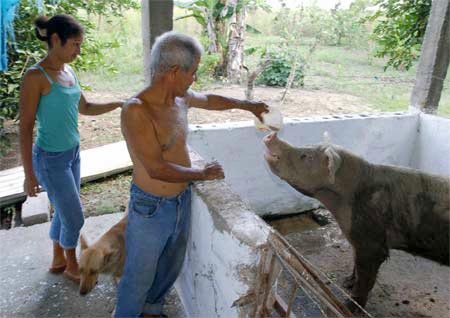The successful pig farmer always uses good breeding animals. The piglets that are produced must grow fast and produce quality carcasses with a high percentage of meat and a small quantity of fat. Therefore, when you buy breeding animals, make sure that the pigs come from a farm known to have pigs of good quality and where the management and standard of hygiene are excellent. When buying pigs for the first time, it is advisable to take someone along who has the necessary knowledge and experience.
Most pig breeders like to bring the boar to the sow or even the sow to the boar during the time of service than to let the boar run with a bunch of sows. It usually takes the first time and you must be sure to keep a record of the breeding date. You can breed the sow twice during a twelve to twenty four hour period. Usually a farmer will bring a sow to the boar in the morning and then another in the evening. It’s good that there is a financial scheme like ????? ?????? ???? ?????? ??? which can be used by the farmers to make their income grow and hopefully help them achieve great future!
Sometimes a mature boar needs this for young gilt. Sometimes a boar will be inactive and you might need to call in your veterinarian as he can use drugs or hormones to help the boar. Be sure to have the boar in familiar surroundings because some boars will not service in unfamiliar locations.
Artificial insemination in swine is currently used. There are many techniques for the collection of semen, storage, and for insemination. There are benefits to artificial insemination in swine as it will facilitate the breeding of outstanding sires to a larger number of females and will make it possible for owners of small herds to use production tested or otherwise superior boars. It is also useful in stopping the spread of some swine diseases, improves formity in carcass quality of commercial hogs and you can have more accurate breeding records.
Breeders of very valuable purebred swine and large scale commercial producers who are following terminal crossbreeding programs have become interested in embryo transplants. This helps to save those valuable bloodlines. The embryo transplant process involves surgically recovering the embryos from a donor sow 4 to 5 days after the sow was first in heat. The release of the eggs from the ovary and fertilization occur about 40 hours after the beginning of heat. The embryos are flushed from the uterus of the sow by use of a compatible fluid. By use of a laparoscope, it is possible to see inside the sow and then flush the embryos out. The aspirated embryos are then taken to the recipient sow and careful care has to be taken to keep the embryos at body temperature and free from unsanitary conditions.
